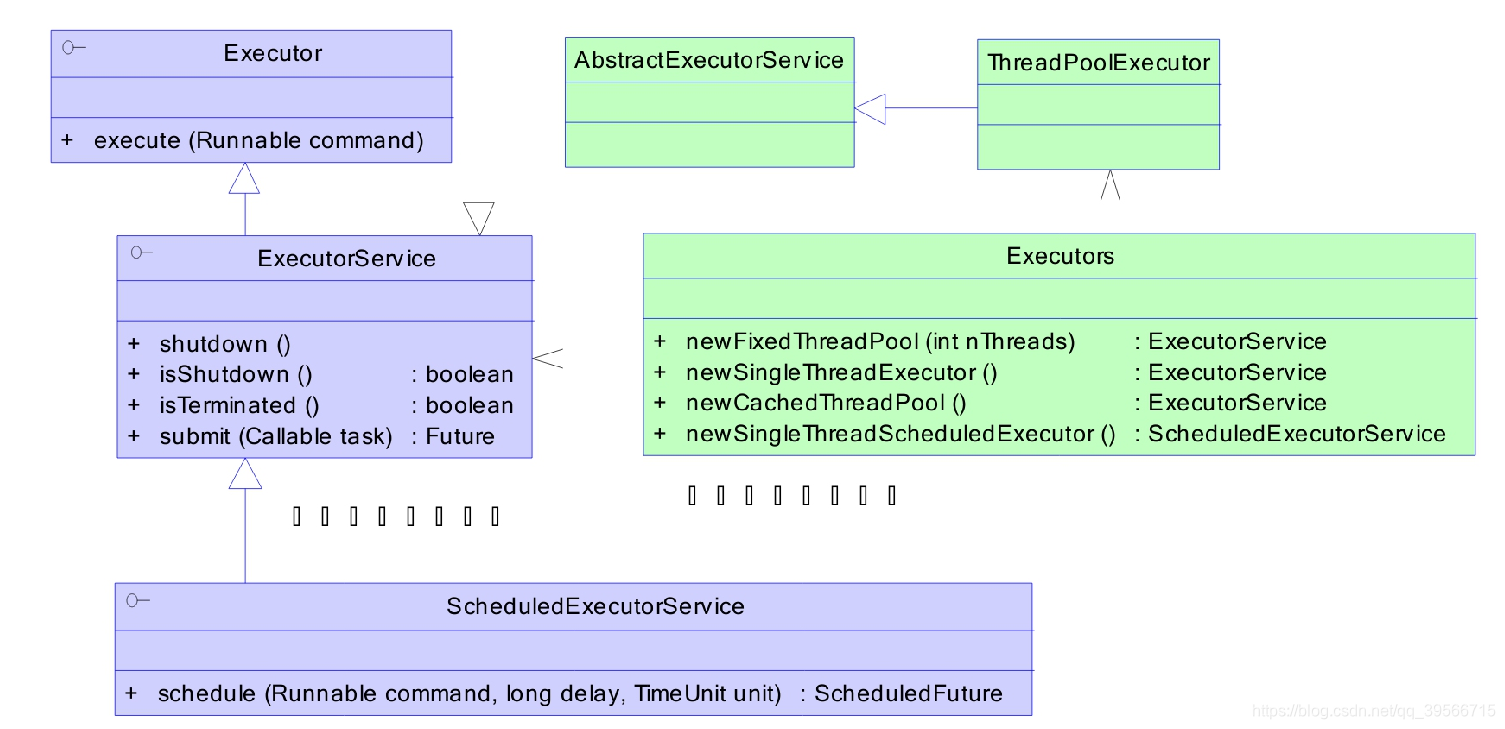
以上成员均在java.util.concurrent包中,是JDK并发包的核心类。其中ThreadPoolExecutor表示一个线程池。Executors类则扮演着线程池工厂的角色,通过Executors可以取得一个拥有特定功能的线程池。从UML图中亦可知,ThreadPoolExecutor类实现了Executor接口,因此通过这个接口,任何Runnable的对象都可以被ThreadPoolExecutor线程池调度。
newFixedThreadPool()方法:该方法返回一个固定线程数量的线程池。该线程池中的线程数量始终不变。当有一个新的任务提交时,线程池中若有空闲线程,则立即执行。若没有,则新的任务会被暂存在一个任务队列中,待有线程空闲时,便处理在任务队列中的任务。
newSingleThreadExecutor()方法:该方法返回一个只有一个线程的线程池。若多余一个任务被提交到该线程池,任务会被保存在一个任务队列中,待线程空闲,按先入先出的顺序执行队列中的任务。
newCachedThreadPool()方法:该方法返回一个可根据实际情况调整线程数量的线程池。线程池的线程数量不确定,但若有空闲线程可以复用,则会优先使用可复用的线程。若所有线程均在工作,又有新的任务提交,则会创建新的线程处理任务。所有线程在当前任务执行完毕后,将返回线程池进行复用。
newSingleThreadScheduledExecutor()方法:该方法返回一个ScheduledExecutorService对象,线程池大小为1。ScheduledExecutorService接口在ExecutorService接口之上扩展了在给定时间执行某任务的功能,如在某个固定的延时之后执行,或者周期性执行某个任务。
newScheduledThreadPool()方法:该方法也返回一个ScheduledExecutorService对象,但该线程池可以指定线程数量。
public class ThreadPoolDemo {
public static class MyTask implements Runnable{
@Override
public void run() {
System.out.println(System.currentTimeMillis()+"Thread ID:"+Thread.currentThread().getId());
try {
Thread.sleep(1000);
} catch (InterruptedException e) {
e.printStackTrace();
}
}
public static void main(String[] args) {
MyTask task = new MyTask();
ExecutorService es = Executors.newFixedThreadPool(3);
for (int i = 0; i<10; i++){
es.submit(task);
}
}
}
}
每一秒执行3个。
换成newCachedThreadPool,会一下子执行完毕。
/** * Creates a thread pool that creates new threads as needed, but * will reuse previously constructed threads when they are * available. These pools will typically improve the performance * of programs that execute many short-lived asynchronous tasks. * Calls to {@code execute} will reuse previously constructed * threads if available. If no existing thread is available, a new * thread will be created and added to the pool. Threads that have * not been used for sixty seconds are terminated and removed from * the cache. Thus, a pool that remains idle for long enough will * not consume any resources. Note that pools with similar * properties but different details (for example, timeout parameters) * may be created using {@link ThreadPoolExecutor} constructors.对应的翻译
创建一个线程池,根据需要创建新线程,但是
*将重用之前构建的线程
*可用。这些池通常会提高性能
执行许多短期的异步任务的程序。
*调用{@code execute}将重用之前构造的
*线程(如果可用)。如果没有可用的线程,则使用新线程
*线程将被创建并添加到池中。线程,
*未使用60秒将终止并删除
*缓存。因此,一个足够长时间保持空闲的池将会
*不消耗任何资源。注意,有类似的池
*属性,但不同的细节(例如,超时参数)
*可以使用{@link ThreadPoolExecutor}构造函数创建。
newScheduledThreadPool(),它返回一个ScheduledExecutorService对象,可以根据时间需要对线程进行调度。

而scheduleAtFixedRate和scheduleWithFixedDelay,它们的任务都开始于给定的初始延时,不同之处在于后期任务,前者按给定的周期,后者是按给定的 延时。
public class ScheduledExecutorServiceDemo {
public static void main(String[] args) {
ScheduledExecutorService ses = Executors.newScheduledThreadPool(10);
ses.scheduleAtFixedRate(new Runnable() {
@Override
public void run() {
try{
Thread.sleep(1000);
System.out.println(System.currentTimeMillis()/1000);
} catch (InterruptedException e) {
e.printStackTrace();
}
}
},0,2, TimeUnit.SECONDS);
}
}
若改变Thread.sleep(5)的时间大于执行周期时间,那么执行周期时间就会变成大的那个时间,比如sleep(5),而执行周期是2秒。那么运行结果的执行周期也会变成5秒。
上面的核心线程池(比如 newFixedThreadPool(),newCachedThreadPool())的内部都实现ThreadPoolExecutor,
其源码:
public ThreadPoolExecutor(int corePoolSize,
int maximumPoolSize,
long keepAliveTime,
TimeUnit unit,
BlockingQueue<Runnable> workQueue) {
this(corePoolSize, maximumPoolSize, keepAliveTime, unit, workQueue,
Executors.defaultThreadFactory(), defaultHandler);
}corePoolSize:指定了线程池中的线程数量。
maximumPoolSize:指定了线程池中的最大线程数量。
keepAliveTime:当线程池线程数量超过corePoolSize时,多余的空闲线程的存活时间。即,超过corePoolSize的空闲线程,在多长时间内,会被销毁。
unit:keepAliveTime的单位。
workQueue:任务队列,被提交但尚未被执行的任务。
threadFactory:线程工厂,用于创建线程,一般用默认的即可。
handler:拒绝策略。当任务太多来不及处理,如何拒绝任务。